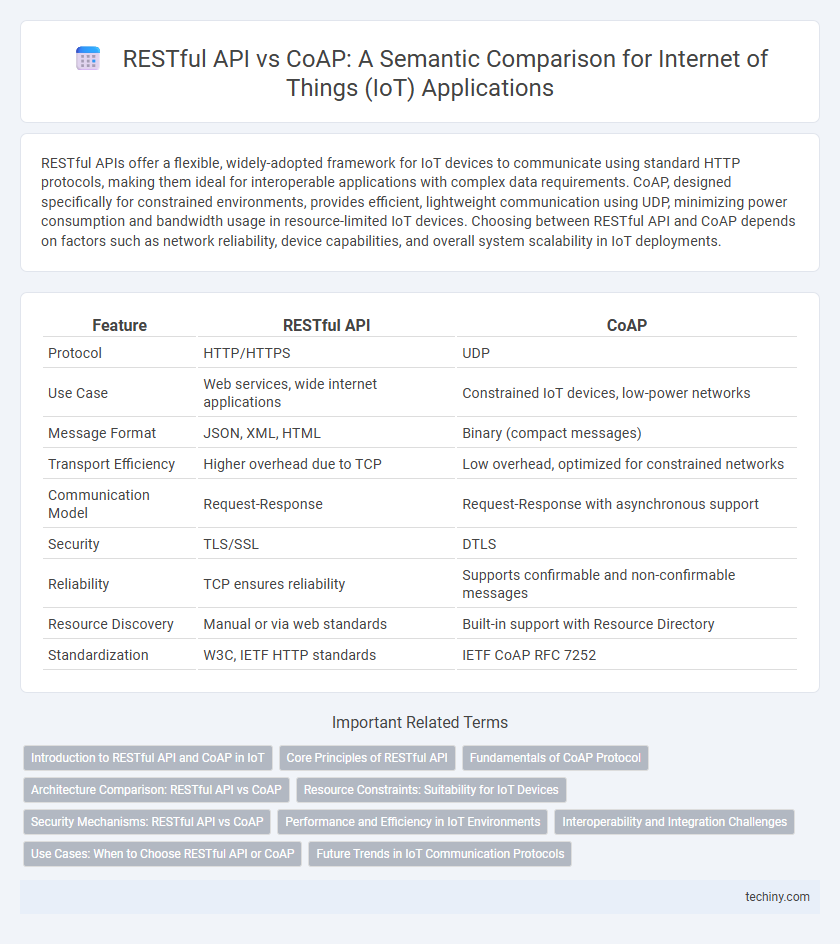RESTful APIs offer a flexible, widely-adopted framework for IoT devices to communicate using standard HTTP protocols, making them ideal for interoperable applications with complex data requirements. CoAP, designed specifically for constrained environments, provides efficient, lightweight communication using UDP, minimizing power consumption and bandwidth usage in resource-limited IoT devices. Choosing between RESTful API and CoAP depends on factors such as network reliability, device capabilities, and overall system scalability in IoT deployments.
Table of Comparison
| Feature | RESTful API | CoAP |
|---|---|---|
| Protocol | HTTP/HTTPS | UDP |
| Use Case | Web services, wide internet applications | Constrained IoT devices, low-power networks |
| Message Format | JSON, XML, HTML | Binary (compact messages) |
| Transport Efficiency | Higher overhead due to TCP | Low overhead, optimized for constrained networks |
| Communication Model | Request-Response | Request-Response with asynchronous support |
| Security | TLS/SSL | DTLS |
| Reliability | TCP ensures reliability | Supports confirmable and non-confirmable messages |
| Resource Discovery | Manual or via web standards | Built-in support with Resource Directory |
| Standardization | W3C, IETF HTTP standards | IETF CoAP RFC 7252 |
Introduction to RESTful API and CoAP in IoT
RESTful API enables seamless communication between IoT devices by leveraging standard HTTP methods to create, read, update, and delete resources, promoting interoperability and scalability across diverse platforms. CoAP (Constrained Application Protocol) is specifically designed for resource-constrained IoT devices, offering low overhead and efficient message exchanges using UDP, ideal for lightweight sensor networks. Both protocols support device-to-device interaction but differ in complexity, with RESTful API favoring more robust, web-based applications and CoAP optimized for constrained environments requiring minimal power and latency.
Core Principles of RESTful API
RESTful APIs operate on stateless communication, using standard HTTP methods like GET, POST, PUT, and DELETE to manage IoT resources efficiently. Their core principles include uniform interface, client-server architecture, and resource-based addressing, which enable scalable and loosely coupled interactions. These principles contrast with CoAP's design, which targets constrained devices through UDP-based lightweight messaging tailored for low power and lossy networks.
Fundamentals of CoAP Protocol
The Constrained Application Protocol (CoAP) is specifically designed for resource-constrained IoT devices, providing a lightweight, UDP-based alternative to RESTful APIs over HTTP. CoAP supports low overhead message exchanges, multicast requests, and asynchronous communication, enabling efficient interactions in low-power and lossy networks common in IoT environments. Its fundamental features include confirmable and non-confirmable message types, built-in reliability through retransmission, URI-based resource identification, and a simple request/response model optimized for minimal processing and bandwidth usage.
Architecture Comparison: RESTful API vs CoAP
RESTful API employs a client-server architecture based on stateless communication over HTTP, enabling scalable and flexible interactions in IoT ecosystems. CoAP utilizes a lightweight, UDP-based protocol designed for constrained devices with a request/response architecture that supports asynchronous communication and multicast. The RESTful API's reliance on HTTP offers broad compatibility and ease of integration, whereas CoAP's architecture optimizes resource usage and low overhead, making it suitable for resource-constrained IoT environments.
Resource Constraints: Suitability for IoT Devices
RESTful API, built on HTTP, demands higher memory and processing power, making it less ideal for resource-constrained IoT devices with limited CPU, RAM, and battery life. CoAP (Constrained Application Protocol) is explicitly designed for low-power, low-bandwidth devices, using lightweight headers and UDP transport to minimize overhead. Its efficiency in handling constrained environments enhances real-time communication and reduces energy consumption, improving IoT device performance.
Security Mechanisms: RESTful API vs CoAP
RESTful APIs typically leverage HTTPS and OAuth 2.0 for robust security, ensuring encrypted communication and secure token-based authentication in IoT applications. CoAP uses Datagram Transport Layer Security (DTLS) to provide encryption, message integrity, and replay protection specifically designed for constrained environments. The choice between RESTful API and CoAP security mechanisms depends on device capabilities, network constraints, and required security levels in IoT deployments.
Performance and Efficiency in IoT Environments
CoAP (Constrained Application Protocol) demonstrates superior performance and efficiency in IoT environments due to its lightweight design and UDP transport, which reduces latency and overhead compared to RESTful APIs that typically rely on HTTP over TCP. CoAP supports features like multicast, low header overhead, and built-in reliability mechanisms optimized for constrained devices and low-power networks, making it ideal for resource-limited IoT sensors and actuators. In contrast, RESTful APIs offer broader compatibility and richer functionality but incur higher resource consumption, impacting scalability and battery life in large-scale IoT deployments.
Interoperability and Integration Challenges
RESTful APIs provide broad interoperability by leveraging HTTP standards and widespread web technologies, simplifying integration with existing internet infrastructure. CoAP is optimized for constrained IoT devices, using a lightweight UDP-based protocol that enhances efficiency but introduces challenges in seamless integration with traditional HTTP-based systems. The fundamental differences in protocol design require bridging solutions like proxies or gateways to achieve effective interoperability and unified communication across diverse IoT platforms.
Use Cases: When to Choose RESTful API or CoAP
RESTful API suits applications requiring stateless interactions with widespread web integration, such as cloud-based IoT platforms and mobile apps. CoAP excels in constrained environments needing low power consumption and efficient message exchanges, including smart home devices and industrial sensor networks. Selecting between RESTful API and CoAP depends on network conditions, device capabilities, and the need for real-time communication or resource optimization.
Future Trends in IoT Communication Protocols
RESTful API and CoAP represent key communication protocols in IoT, with RESTful APIs leveraging HTTP for broad interoperability and CoAP designed for constrained environments using UDP to minimize overhead. Future trends indicate a convergence where hybrid protocols enhance scalability, security, and efficiency to meet IoT demands, integrating edge computing and AI-driven network management. Advancements in lightweight encryption and adaptive transmission techniques will drive protocol evolution to support massive device connectivity and real-time data exchange.
RESTful API vs CoAP Infographic

 techiny.com
techiny.com